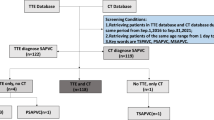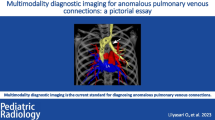Abstract
Objectives
The objective of this study was to investigate the effect of location and number of anomalously connected pulmonary veins and any associated atrial septal defect (ASD) on the magnitude of left-to-right shunting in patients with partial anomalous pulmonary venous connection (PAPVC), and how that influences right ventricular volume loading.
Methods and results
The cardiac magnetic resonance (CMR) and echocardiography examinations of 26 paediatric patients (mean age, 11.2 ± 5.1 years) with unrepaired PAPVC were analysed. Fourteen patients had right-sided, 11 left-sided and 1 patient bilateral PAPVC. An ASD was present in 11 patients, of which none had a Qp/Qs < 1.5 and 8 had a Qp/Qs≥ 2.0. No patient with isolated left upper PAPVC experienced a Qp/Qs ≥ 2.0 compared to 9/12 patients with right upper PAPVC. Qp/Qs correlated with indexed right ventricle (RV) end-diastolic volume (RVEDVi, r = 0.59, p = 0.002) by CMR and with echocardiographic right ventricular end-diastolic dimension (RVED) z-score (r = 0.68, p = 0.003). A RVEDVi >124 ml/m2 by CMR and a RVED z-score >2.2 by echocardiography identified patients with a Qp/Qs ≥1.5 with good sensitivity and specificity.
Conclusions
An asymptomatic patient with a single anomalously connected left upper pulmonary vein and without an ASD is unlikely to have a significant left-to-right shunt. On the other hand, right-sided PAPVC is frequently associated with a significant left-to-right shunt, especially when an ASD is present.
Key Points
• Patients with PAPVC and ASD routinely have a significant left-to-right shunt.
• Patients with right PAPVC are likely to have a significant left-to-right shunt.
• Patients with left PAPVC are unlikely to have a significant left-to-right shunt.
• CMR is helpful in decision-making for patients with PAPVC.




Similar content being viewed by others
Abbreviations
- ASD:
-
Atrial septal defect
- CMR:
-
Cardiac magnetic resonance
- LPA:
-
Left branch pulmonary arteries
- LUPV:
-
Left upper pulmonary vein
- PAPVC:
-
Partial anomalous pulmonary venous connection
- PC CMR:
-
Phase contrast cardiac magnetic resonance imaging
- RMPV:
-
Right middle pulmonary vein
- RPA:
-
Right branch pulmonary arteries
- RUPV:
-
Right upper pulmonary vein
- RV:
-
Right ventricle
- RVED:
-
Right ventricular end-diastolic dimension
- SVC:
-
Superior vena cava
- TPBF:
-
Total pulmonary blood flow
References
Healey JE Jr (1952) An anatomic survey of anomalous pulmonary veins: their clinical significance. J Thorac Surg 23:433–444
Alsoufi B, Cai S, Van Arsdell GS, Williams WG, Caldarone CA, Coles JG (2007) Outcomes after surgical treatment of children with partial anomalous pulmonary venous connection. Ann Thorac Surg 84:2020–2026 discussion 2026
Brown DW, Geva T (2013) Anomalies of the pulmonary veins. In: Allen HD, Driscoll DJ, Shaddy RE, Feltes TF (eds) Moss and Adams heart disease in infants, children, and adolescents : including the fetus and young adult, 8th edn. Lippincott Williams & Wilkins, Philadelphia, pp 809–839
Rudolph A (2001) Atrial septal defect and partial anomalous drainage of pulmonary veins. In: Rudolph A (ed) Congenital diseases of the heart: clinical-physiological considerations, 2nd edn. Futura Publishing Company, Armonk, pp 245–282
Kouchoukos NT, Blackstone EH, Hanley FL, Kirlin JK (2013) Atrial septal defect and partial anomalous pulmonary venous connection. In: Kouchoukos NT, Blackstone EH, Hanley FL, Kirlin JK (eds) Kirklin/Barratt-Boyes Cardiac surgery, 4th edn. Saunders, Philadelphia, pp 1150–1182
Andersen M, Moller I, Lyngborg K, Wennevold A (1976) The natural history of small atrial septal defects; long-term follow-up with serial heart catheterizations. Am Heart J 192:302–307
Alpert JS, Dexter L, Vieweg WV, Haynes FW, Dalen JE (1977) Anomalous pulmonary venous return with intact atrial septum: diagnosis and pathophysiology. Circulation 156:870–875
Tajik AJ, Gau GT, Ritter DG, Schattenberg TT (1972) Echocardiographic pattern of right ventricular diastolic volume overload in children. Circulation 46:36–43
Goo HW, Al-Otay A, Grosse-Wortmann L, Wu S, Macgowan CK, Yoo SJ (2009) Phase-contrast magnetic resonance quantification of normal pulmonary venous return. J Magn Reson Imaging 29:588–594
Grosse-Wortmann L, Al-Otay A, Goo HW et al (2007) Anatomical and functional evaluation of pulmonary veins in children by magnetic resonance imaging. J Am Coll Cardiol 49:993–1002
Valsangiacomo ER, Barrea C, Macgowan CK, Smallhorn JF, Coles JG, Yoo SJ (2003) Phasecontrast MR assessment of pulmonary venous blood flow in children with surgically repaired pulmonary veins. Pediatr Radiol 33:607–613
Valsangiacomo ER, Levasseur S, McCrindle BW, MacDonald C, Smallhorn JF, Yoo SJ (2003) Contrast-enhanced MR angiography of pulmonary venous abnormalities in children. Pediatr Radiol 33:92–98
Kellenberger CJ, Yoo SJ, Buchel ER (2007) Cardiovascular MR imaging in neonates and infants with congenital heart disease. Radiographics 27:5–18
Bryan AC, Bentivoglio LG, Beerel F, Macleish H, Zidulka A, Bates DV (1964) Factors affecting regional distribitution of ventilation and perfusion of the lung. J Appl Physiol 19:395–402
Marom EM, Herndon JE, Kim YH, McAdams HP (2004) Variations in pulmonary venous drainage to the left atrium: implications for radiofrequency ablation. Radiology 230:824–829
Kato R, Lickfett L, Meininger G et al (2003) Pulmonary vein anatomy in patients undergoing catheter ablation of atrial fibrillation: lessons learned by use of magnetic resonance imaging. Circulation 107:2004–2010
Lopez L, Colan SD, Frommelt PC et al (2010) Recommendations for quantification methods during the performance of a pediatric echocardiogram: a report from the Pediatric Measurements Writing Group of the American Society of Echocardiography Pediatric and Congenital Heart Disease Council. J Am Soc Echocardiogr 23:465–495 quiz 576-7
Lai WW, Geva T, Shirali GS et al (2006) Guidelines and standards for performance of a pediatric echocardiogram: a report from the Task Force of the Pediatric Council of the American Society of Echocardiography. J Am Soc Echocardiogr 19:1413–1430
Lai WW, Gauvreau K, Rivera ES, Saleeb S, Powell AJ, Geva T (2008) Accuracy of guideline recommendations for two-dimensional quantification of the right ventricle by echocardiography. Int J Cardiovasc Imaging 24:691–698
Daubeney PE, Blackstone EH, Weintraub RG, Slavik Z, Scanlon J, Webber SA (1999) Relationship of the dimension of cardiac structures to body size: an echocardiographic study in normal infants and children. Cardiol Young 9:402–410
Saalouke MG, Shapiro SR, Perry LW, Scott LP 3rd (1977) Isolated partial anomalous pulmonary venous drainage associated with pulmonary vascular obstructive disease. Am J Cardiol 39:439–444
Babb JD, McGlynn TJ, Pierce WS, Kirkman PM (1981) Isolated partial anomalous venous connection: a congenital defect with late and serious complications. Ann Thorac Surg 31:540–541
Ward KE, Mullins CE (1998) Anomalous pulmonary venous connections, pulmonary vein stenosis, and atresia of the common pulmonary vein. In: Garson AJ, Bricker JT, Fischer DJ, Neish SR (eds) The science and practice of pediatric cardiology, 2nd edn. Williams & Wilkins, Baltimore, pp 1431–1461
Hancock Friesen CL, Zurakowski D, Thiagarajan RR et al (2005) Total anomalous pulmonary venous connection: an analysis of current management strategies in a single institution. Ann Thorac Surg 79:596–606 discussion 596-606
Caldarone CA, Najm HK, Kadletz M et al (1998) Relentless pulmonary vein stenosis after repair of total anomalous pulmonary venous drainage. Ann Thorac Surg 66:1514–1520
Greenway SC, Yoo SJ, Baliulis G, Caldarone C, Coles J, Grosse-Wortmann L (2011) Assessment of pulmonary veins after atrio-pericardial anastomosis by cardiovascular magnetic resonance. J Cardiovasc Magn Reson 13:72
Said SM, Burkhart HM, Schaff HV et al (2012) Single-patch, 2-patch, and caval division techniques for repair of partial anomalous pulmonary venous connections: does it matter? J Thorac Cardiovasc Surg 143:896–903
Buz S, Alexi-Meskishvili V, Villavicencio-Lorini F et al (2009) Analysis of arrhythmias after correction of partial anomalous pulmonary venous connection. Ann Thorac Surg 87:580–583
Feltes TF, Bacha E, Beekman RH 3rd et al (2011) Indications for cardiac catheterization and intervention in pediatric cardiac disease: a scientific statement from the American Heart Association. Circulation 123:2607–2652
Boehrer JD, Lange RA, Willard JE, Grayburn PA, Hillis LD (1992) Advantages and limitations of methods to detect, localize, and quantitate intracardiac left-to-right shunting. Am Heart J 124:448–455
Beerbaum P, Korperich H, Barth P, Esdorn H, Gieseke J, Meyer H (2001) Noninvasive quantification of left-to-right shunt in pediatric patients: phase-contrast cine magnetic resonance imaging compared with invasive oximetry. Circulation 103:2476–2482
Festa P, Ait-Ali L, Cerillo AG, De Marchi D, Murzi B (2006) Magnetic resonance imaging is the diagnostic tool of choice in the preoperative evaluation of patients with partial anomalous pulmonary venous return. Int J Cardiovasc Imaging 22:685–693
Roman KS, Kellenberger CJ, Macgowan CK et al (2005) How is pulmonary arterial blood flow affected by pulmonary venous obstruction in children? A phasecontrast magnetic resonance study. Pediatr Radiol 35:580–586
Henk CB, Schlechta B, Grampp S, Gomischek G, Klepetko W, Mostbeck GH (1998) Pulmonary and aortic blood flow measurements in normal subjects and patients after single lung transplantation at 0.5 T using velocity encoded cine MRI. Chest 114:771–779
Ley S, Fink C, Puderbach M et al (2006) MRI Measurement of the hemodynamics of the pulmonary and systemic arterial circulation: influence of breathing maneuvers. AJR Am J Roentgenol 187:439–444
Dollery CT, West JB, Wilcken DE, Hugh-Jones P (1961) A comparison of the pulmonary blood flow between left and right lungs in normal subjects and patients with congenital heart disease. Circulation 24:617–625
Johnson MC, Sekarski TJ, Balzer DT (2000) Echocardiographic prediction of left-to-right shunt with atrial septal defects. J Am Soc Echocardiogr 13:1038–1042
Laurenceau JL, Dumesnil JG, Gagne S (1975) Echocardiographic evaluation of the significance of shunt in secondary communications and in partial abnormal pulmonary venous returns. Arch Mal Coeur Vaiss 68:619–624
Greutmann M, Tobler D, Biaggi P et al (2012) Echocardiography for assessment of regional and global right ventricular systolic function in adults with repaired tetralogy of Fallot. Int J Cardiol 157:53–58
Mertens LL, Friedberg MK (2010) Imaging the right ventricle—current state of the art. Nat Rev Cardiol 7:551–563
Funding
The authors state that this work has not received any funding.
Author information
Authors and Affiliations
Corresponding author
Ethics declarations
Guarantor
The scientific guarantor of this publication is Dr. Shi-Joon Yoo.
Conflict of interest
The authors of this manuscript declare no relationships with any companies, whose products or services may be related to the subject matter of the article.
Statistics and biometry
One of the authors has significant statistical expertise.
No complex statistical methods were necessary for this paper.
Ethical approval
Institutional Review Board approval was obtained.
Informed consent
Written informed consent was waived by the Institutional Review Board.
Methodology
• retrospective
• cross-sectional study, diagnostic or prognostic study, observational
• performed at one institution
Rights and permissions
About this article
Cite this article
Seller, N., Yoo, SJ., Grant, B. et al. How many versus how much: comprehensive haemodynamic evaluation of partial anomalous pulmonary venous connection by cardiac MRI. Eur Radiol 28, 4598–4606 (2018). https://doi.org/10.1007/s00330-018-5428-9
Received:
Revised:
Accepted:
Published:
Issue Date:
DOI: https://doi.org/10.1007/s00330-018-5428-9




